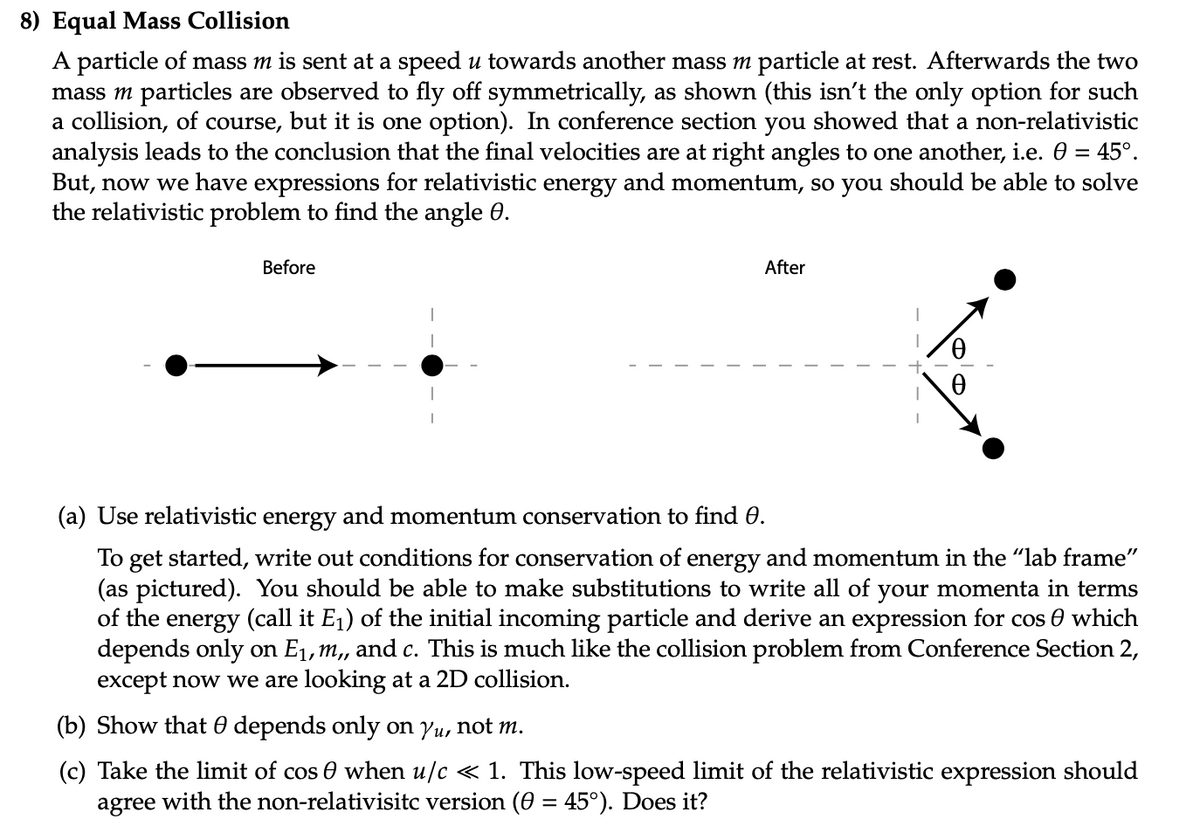A particle of mass m is sent at a speed u towards another mass m particle at rest. Afterwards the two mass m particles are observed to fly off symmetrically, as shown (this isn't the only option for such a collision, of course, but it is one option). In conference section you showed that a non-relativistic analysis leads to the conclusion that the final velocities are at right angles to one another, i.e. 0 = 45°. But, now we have expressions for relativistic energy and momentum, so you should be able to solve the relativistic problem to find the angle 0. Before After (a) Use relativistic energy and momentum conservation to find 0. To get started, write out conditions for conservation of energy and momentum in the “lab frame" (as pictured). You should be able to make substitutions to write all of your momenta in terms of the energy (call it E1) of the initial incoming particle and derive an expression for cos 0 which depends only on E1,m,, and c. This is much like the collision problem from Conference Section 2, except now we are looking at a 2D collision. (b) Show that 0 depends only on yu, not m. (c) Take the limit of cos 0 when u/c « 1. This low-speed limit of the relativistic expression should agree with the non-relativisitc version (0 = 45°). Does it? %3D
A particle of mass m is sent at a speed u towards another mass m particle at rest. Afterwards the two mass m particles are observed to fly off symmetrically, as shown (this isn't the only option for such a collision, of course, but it is one option). In conference section you showed that a non-relativistic analysis leads to the conclusion that the final velocities are at right angles to one another, i.e. 0 = 45°. But, now we have expressions for relativistic energy and momentum, so you should be able to solve the relativistic problem to find the angle 0. Before After (a) Use relativistic energy and momentum conservation to find 0. To get started, write out conditions for conservation of energy and momentum in the “lab frame" (as pictured). You should be able to make substitutions to write all of your momenta in terms of the energy (call it E1) of the initial incoming particle and derive an expression for cos 0 which depends only on E1,m,, and c. This is much like the collision problem from Conference Section 2, except now we are looking at a 2D collision. (b) Show that 0 depends only on yu, not m. (c) Take the limit of cos 0 when u/c « 1. This low-speed limit of the relativistic expression should agree with the non-relativisitc version (0 = 45°). Does it? %3D
Principles of Physics: A Calculus-Based Text
5th Edition
ISBN:9781133104261
Author:Raymond A. Serway, John W. Jewett
Publisher:Raymond A. Serway, John W. Jewett
Chapter31: Particle Physics
Section: Chapter Questions
Problem 56P
Related questions
Question
100%
Please make sure to use relativistic energy and momentum and not Newtonian. Thanks!

Transcribed Image Text:8) Equal Mass Collision
A particle of mass m is sent at a speed u towards another mass m particle at rest. Afterwards the two
mass m particles are observed to fly off symmetrically, as shown (this isn't the only option for such
a collision, of course, but it is one option). In conference section you showed that a non-relativistic
analysis leads to the conclusion that the final velocities are at right angles to one another, i.e. 0 = 45°.
But, now we have expressions for relativistic energy and momentum, so you should be able to solve
the relativistic problem to find the angle 0.
Before
After
(a) Use relativistic energy and momentum conservation to find 0.
To get started, write out conditions for conservation of energy and momentum in the "lab frame"
(as pictured). You should be able to make substitutions to write all of your momenta in terms
of the energy (call it E1) of the initial incoming particle and derive an expression for cos 0 which
depends only on E1, m,, and c. This is much like the collision problem from Conference Section 2,
except now we are looking at a 2D collision.
(b) Show that 0 depends only on yu, not m.
(c) Take the limit of cos 0 when u/c « 1. This low-speed limit of the relativistic expression should
agree with the non-relativisitc version (0 = 45°). Does it?
Expert Solution
This question has been solved!
Explore an expertly crafted, step-by-step solution for a thorough understanding of key concepts.
This is a popular solution!
Trending now
This is a popular solution!
Step by step
Solved in 5 steps with 1 images

Knowledge Booster
Learn more about
Need a deep-dive on the concept behind this application? Look no further. Learn more about this topic, physics and related others by exploring similar questions and additional content below.Recommended textbooks for you

Principles of Physics: A Calculus-Based Text
Physics
ISBN:
9781133104261
Author:
Raymond A. Serway, John W. Jewett
Publisher:
Cengage Learning

College Physics
Physics
ISBN:
9781305952300
Author:
Raymond A. Serway, Chris Vuille
Publisher:
Cengage Learning

College Physics
Physics
ISBN:
9781938168000
Author:
Paul Peter Urone, Roger Hinrichs
Publisher:
OpenStax College

Principles of Physics: A Calculus-Based Text
Physics
ISBN:
9781133104261
Author:
Raymond A. Serway, John W. Jewett
Publisher:
Cengage Learning

College Physics
Physics
ISBN:
9781305952300
Author:
Raymond A. Serway, Chris Vuille
Publisher:
Cengage Learning

College Physics
Physics
ISBN:
9781938168000
Author:
Paul Peter Urone, Roger Hinrichs
Publisher:
OpenStax College

College Physics
Physics
ISBN:
9781285737027
Author:
Raymond A. Serway, Chris Vuille
Publisher:
Cengage Learning

University Physics Volume 3
Physics
ISBN:
9781938168185
Author:
William Moebs, Jeff Sanny
Publisher:
OpenStax

Physics for Scientists and Engineers with Modern …
Physics
ISBN:
9781337553292
Author:
Raymond A. Serway, John W. Jewett
Publisher:
Cengage Learning